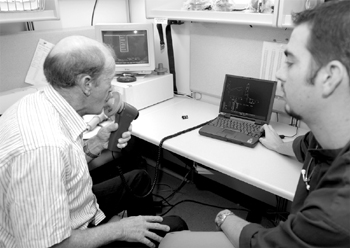
Gibson is administered the peak-flow test at the Vanderbilt Asthma, Sinus & Allergy Program last week by research coordinator Josh Cooper. After two weeks on the treatment plan Gibson’s test results are improving. (photo by Anne Rayner Pollo)
Vanderbilt team working to halt smoking disease
Researchers at the Vanderbilt Asthma, Sinus & Allergy Program (VASAP) are seeking long-term smokers to test a new medication to treat symptoms of smoking-related chronic obstructive pulmonary disease (COPD), similar to emphysema.
The early Phase II trial of a new drug, OPC-6535, a phosphodiesterase (PDE) type 4 inhibitor, will determine if the drug can halt progression and reverse the symptoms of the life-threatening respiratory disease.
Dr. John J. Murray, associate professor of Medicine and associate professor of Pharmacology, is seeking 12 individuals, age 40 or over, who have 10 or more pack years of smoking and have symptoms associated with COPD such as smoker’s cough or shortness of breath. A pack year of smoking is defined as having smoked at least one pack of cigarettes per day for one year.
“This medicine works similarly to Theophylline, but without toxicities, such as arrhythmias, seizures, nausea or vomiting,” said Murray.
“There are now at least 15 different phosphodiesterases that have been identified in the body,” he said. “Phosphodiesterase IV is an important one because it is located in the neutrophils, or the inflammatory cells, of the lung, as well as the smooth muscle of the lung. The medication acts by inhibiting neutrophil infiltration and activation of phosphodiesterase IV that destroys lung tissue, but not inhibiting the other 14 phosphodiesterases. That way it offers the benefits but doesn’t cause the side effects. Hopefully it will be a more useful and specific type of Theophylline.”
According to the Centers for Disease Control and Prevention, COPD was responsible for 8 million physician office and hospital outpatient visits, 1.5 million emergency department visits, 726,000 hospitalizations, and 119,000 deaths during 2000.
In that same year, an estimated 10 million U.S. adults reported physician-diagnosed COPD. However, the CDC estimates that approximately 24 million U.S. adults have evidence of impaired lung function, suggesting COPD is under diagnosed.
“Current figures indicate that one-half of people who smoke will die from smoking-related lung disease,” said Murray. “COPD is the No. 3 cause of death overall. In terms of overall morbidity and cost it ranks very high.
“COPD is a preventable disease. Over 90 percent of people wouldn’t get it if they didn’t smoke. If a patient does get COPD, but stops smoking, they can go into remission. Twenty-five percent of people do go into remission if they stop smoking. But it’s very hard to stop.”
Murray said the difficulty that most individuals have quitting smoking necessitates a need for new, more effective treatments for COPD.
The first participant in the COPD trial, Dan Gibson, 57, of Watertown, Tenn., grew up on a tobacco farm in Eastern Kentucky and began experimenting with tobacco at age 10. He became a full-time smoker at the age of 17 and was hooked for good during his career in the military.
Gibson tried to quit smoking for years. “It’s terrible,” he said. “ I’m on my fifth attempt, this time with a pill and a patch, and it finally seems to be working.
“The best advice I can ever give anyone is don’t start. Smoking is a terrible addiction.”
Gibson said he began to feel the symptoms of COPD, such as shortness of breath and elevated pulse during exertion, about five or six years ago while performing difficult tasks in his construction job or while working strenuously at home. Incidentally, Gibson’s father died of COPD in 1993.
The lifelong smoker’s breathing became so labored, and the risk of fainting so great, that he had to leave his construction job late last year and is now on disability.
Knowing there was “no real drug treatment available” for the disease, Gibson has been waiting for the opportunity to try a new medication to ease his symptoms.
“I don’t know, but I believe they may be on to something,” he said. “I’ve been on the drug for two weeks and my peak-flow (breathing) tests are showing an improvement.”
Murray said that everyone, smokers and nonsmokers, looses lung function as they age. However, smokers loose lung function at twice the rate. Lost lung function isn’t recoverable. Murray said that when compared side by side on a graph the slope of loss of lung function in moderate to heavy smokers is much steeper, usually indicating a disability level by age 65.
“Presently, there isn’t any medication that can modify this process of the destruction of the lung. What we hope this new medication can do is change that slope and slow down, or perhaps halt the loss of lung function in these smokers,” said Murray.
Murray said the ultimate goal of all physicians should be to encourage smokers to stop. “The earlier you can get someone to stop smoking, you can give them a much longer life. If someone keeps smoking past age 65, then they will almost certainly be dead within another 10 years,” he said.
For more information about the study, call the VASAP research staff at 936-5764.













